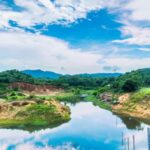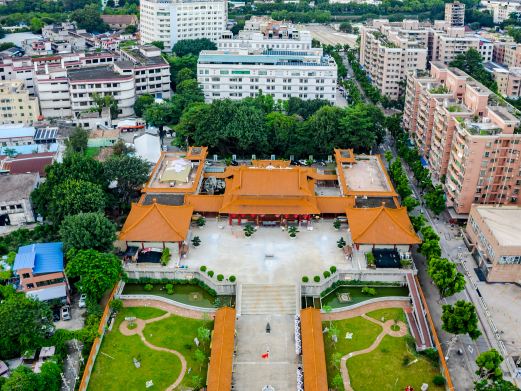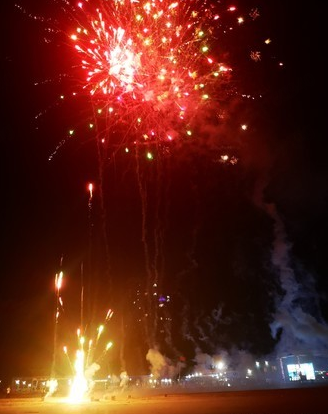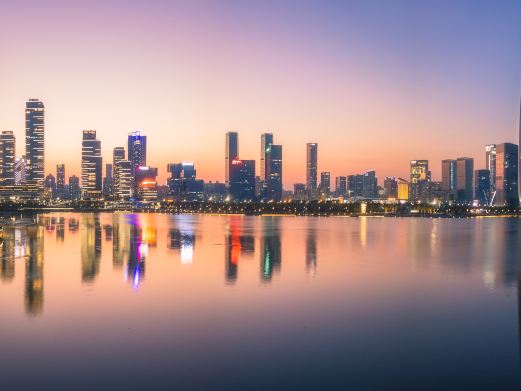Shi Bi Mountain Scenic Area is lush with verdant trees, featuring ancient trees and famous woods fro[...]
Shi Bi Mountain Scenic Area is lush with verdant trees, featuring ancient trees and famous woods from the Ming Dynasty, newly planted Doctor’s Forest, the ancient temple ‘Lei Yin Temple’, natural scenic spot ‘Jian Yu Spring’, and modern structures such as the ‘Yue Dong Yi Bi’ (inscribed by Zhao Puchu) archway, Na Hai Tower, Li Ze Lake, and Fei Hong Bridge.
Lei Yin Ancient Temple

Lei Yin Ancient Temple is located on the southern slope of Qi Yun Mountain. In the 28th year of the Jiajing era of the Ming Dynasty (1532), a stone pavilion was built by Yu San from Huang Gang Shangbu Village next to the Chang Shen Cave on Qi Yun Mountain. The pavilion was inhabited to guard the tomb in front (the ancient tomb is called ‘Huang Niu Ting Jin Zhong’). Incense and candles were regularly offered to the mountain god of Chang Shen Cave for safety and peace.
Over time, it evolved into Lei Yin Ancient Temple. During the Qianlong era of the Qing Dynasty, an anomaly occurred in a kiln in Jingdezhen, Jiangxi, resulting in eighteen Arhats. Each Arhat had the words ‘Chaozhou Lei Yin Ancient Temple’ on their back. The county official reported to the court, and the Emperor ordered a search for Lei Yin Temple in Chaozhou. After a frantic search across counties, the ‘Lei Yin Ancient Temple’ was eventually found next to Chang Shen Cave on Qi Yun Mountain in Huang Gang.
Due to the striking resemblance between the temple’s eighteen Arhats and the kiln images, and the temple’s use of the large rock of Shang Shen Cave as its rear wall, later generations also referred to Lei Yin Temple as ‘Shi Bi An’, and the original Qi Yun Mountain became known as Shi Bi Mountain.

Jian Yu Spring

Jian Yu Spring is located in the valley of Shi Bi Mountain. Surrounded by ancient trees providing shade, a towering rock covers several stones, forming a stone cave. The cave entrance is 1 meter high and 1.7 meters wide, extending 5 meters in both length and width. Inside the cave, there is a large stone that leans forward following the mountain’s slope, with two winding small stone ditches extending from the bottom, constantly emitting clear springs that converge at the cave entrance and flow out, resembling a dragon spitting water.
In the third year of the Jiajing era of the Ming Dynasty (1524), Yu Weng engraved the three large characters ‘Jian Yu Spring’ on the large rock; in the sixteenth year of the Qianlong era (1752), Xu Zhiliang inscribed two poems titled ‘Yu Quan Liu Ti’; in the sixth year of the Tongzhi era (1867), Feng Gang’s military envoy Zhang Dianxiong inscribed a five-couplet poem, all praising Jian Yu Spring.
Tip: There is a Gongfu tea seat by Jian Yu Spring, and it’s quite pleasant to have a few friends over for tea, chat, and cards on a summer afternoon (10 yuan per table).
Na Hai Tower
Na Hai Tower is located at the summit of Shi Bi Mountain in Huang Gang Town, Rao Ping County. It covers an area of 500 square meters. Climbing the tower offers a panoramic view of Huang Gang and the vast South China Sea, embodying the philosophy of the times, like the ocean, it accepts all rivers to show greatness; it can hold the broad mind of the ocean, hence the name. The tower was built from April 1991 to September 1992, made of reinforced concrete, with double-layered six-column structure.
The architecture integrates traditional ancient building craftsmanship, with upturned eaves and corners, golden glazed green tiles, surrounding corridors, and protected by red-painted railings. Both upstairs and downstairs, the beams and columns are carved with mythological scenes, ancient costume drama screens, and exotic flowers and plants.
The plaque of Na Hai Lou is inscribed by the renowned painter and calligrapher Guan Shanyue.
It is a popular tourist destination.
The site is open throughout the year from 08:30 to 22:00, with specific business hours subject to the day’s opening status.












